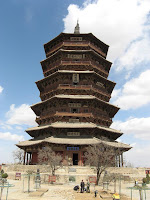 Next day I met up with Trevor who is teaching Beijing and who I met on yesterday's trip. We found a bus heading to Datong South station and after a 30 minute drive through various parts of this larger than I imagined city (that's the case with most Chinese cities though), we arrived in Datong South bus station, bought a ticket to Yingxian (应县), went to the bus and found it was already driving out of the station. Quick dash and we caught it up at the gate, which is usually easy in Chinese bus stations as they have to fill out some paperwork nonsense before leaving the station, which usually takes a minute or two. Yingxian is a small town, but home to the oldest wooden building in China, a wooden pagoda (应县木塔, Yingxianmuta), built in 1056 during the Liao dynasty. It was originally constructed of entirely wood, with no metal nails, but there are plenty there now. The wooden structure is a network of beams and interlocking brackets that function well, as the pagoda has survived seven earthquakes. The area around the pagoda is currently under redevelopment with new (but traditional style) buildings being built in front, housing tourist shops and restaurants, while outside of here and to the west and east, new high rise flats are being constructed replacing the old buildings that used to be home to local residents. On the way back to the station we again caused excitement amongst the staff of a restaurant where we went for lunch. They seemed wary and kept nudging each other to go and serve us, but we eventually, as is often the case received, the full service with all three or four waitresses taking our order while we tried to work out and communicate what we wanted.
Next day I met up with Trevor who is teaching Beijing and who I met on yesterday's trip. We found a bus heading to Datong South station and after a 30 minute drive through various parts of this larger than I imagined city (that's the case with most Chinese cities though), we arrived in Datong South bus station, bought a ticket to Yingxian (应县), went to the bus and found it was already driving out of the station. Quick dash and we caught it up at the gate, which is usually easy in Chinese bus stations as they have to fill out some paperwork nonsense before leaving the station, which usually takes a minute or two. Yingxian is a small town, but home to the oldest wooden building in China, a wooden pagoda (应县木塔, Yingxianmuta), built in 1056 during the Liao dynasty. It was originally constructed of entirely wood, with no metal nails, but there are plenty there now. The wooden structure is a network of beams and interlocking brackets that function well, as the pagoda has survived seven earthquakes. The area around the pagoda is currently under redevelopment with new (but traditional style) buildings being built in front, housing tourist shops and restaurants, while outside of here and to the west and east, new high rise flats are being constructed replacing the old buildings that used to be home to local residents. On the way back to the station we again caused excitement amongst the staff of a restaurant where we went for lunch. They seemed wary and kept nudging each other to go and serve us, but we eventually, as is often the case received, the full service with all three or four waitresses taking our order while we tried to work out and communicate what we wanted.


Left: Giant incense sticks at Huayuan temple (look relative to building behind).
Centre: A dragon form Datong's Nine Dragon Screen.
Right: Bundles of money used for I don't know what. (see previous Datong item).
Back in Datong, we visited the city temples and the nine dragon screen. At forty-five metres long and eight metres high, this is the largest nine dragon screen in China. With nine different dragons detailed in glazed tiles, different colours and curling in different shapes, it is colourful and lively display.
Huayuan Temple originally constructed during the Liao dynasty in 1062, has two parts, which annoyingly means you also have to pay twice. The main hall in the upper temple is the second largest in China and these temples are unusual for facing East, as they were constructed by a sect that worshipped the Sun, Chinese temples generally face South.



No comments:
Post a Comment